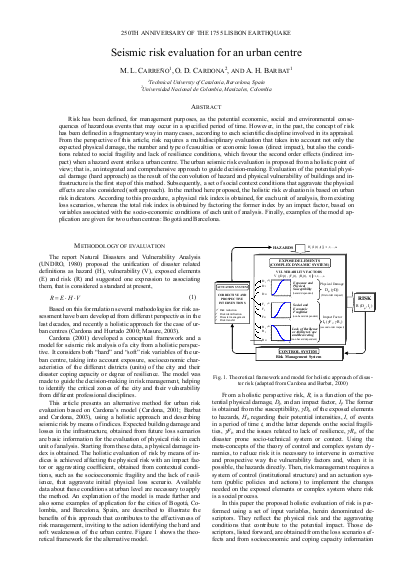
Risk has been defined, for management purposes, as the potential economic, social and environmental conse- quences of hazardous events that may occur in a specified period of time. However, in the past, the concept of risk has been defined in a fragmentary way in many cases, according to each scientific discipline involved in its appraisal. From the perspective of this article, risk requires a multidisciplinary evaluation that takes into account not only the expected physical damage, the number and type of casualties or economic losses (direct impact), but also the condi- tions related to social fragility and lack of resilience conditions, which favour the second order effects (indirect im- pact) when a hazard event strike a urban centre. The urban seismic risk evaluation is proposed from a holistic point of view; that is, an integrated and comprehensive approach to guide decision-making. Evaluation of the potential physi- cal damage (hard approach) as the result of the convolution of hazard and physical vulnerability of buildings and in- frastructure is the first step of this method. Subsequently, a set of social context conditions that aggravate the physical effects are also considered (soft approach). In the method here proposed, the holistic risk evaluation is based on urban risk indicators. According to this procedure, a physical risk index is obtained, for each unit of analysis, from existing loss scenarios, whereas the total risk index is obtained by factoring the former index by an impact factor, based on variables associated with the socio-economic conditions of each unit of analysis. Finally, examples of the model ap- plication are given for two urban centres: Bogotá and Barcelona.
Resource collections
- Evaluating humanitarian action
- Monitoring and Evaluation (M&E)
- Monitoring of humanitarian action
- UN Habitat - Urban Response Collection
- Urban Response - Urban Crisis Preparedness and Risk Reduction
- Urban Response Collection - Community Engagement and Social Cohesion
- Urban Response Collection - Economic Recovery
- Urban Response Collection - Environment and Climate Change
- Urban Response Collection - Housing, Land and Property
- Urban Response Collection - Urban Crisis Response, Recovery and Reconstruction
- Urban Response Collection - Urban Resilience
- Use of evaluation evidence